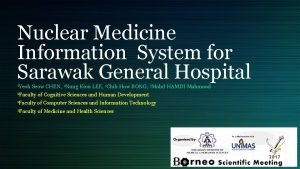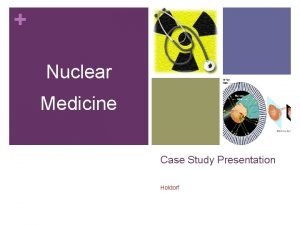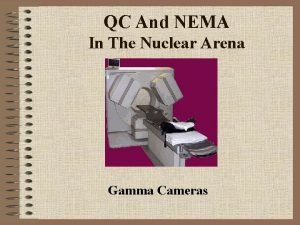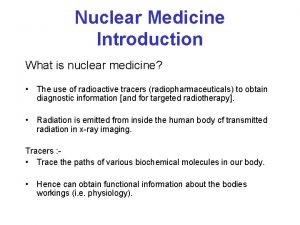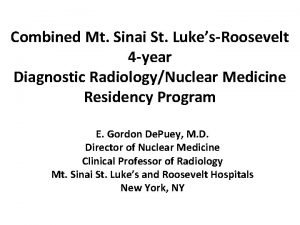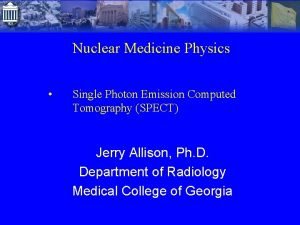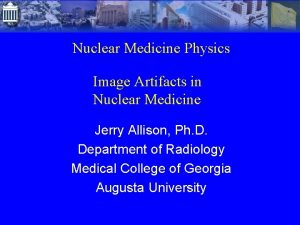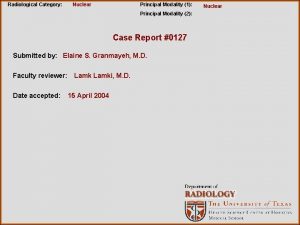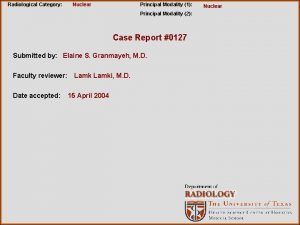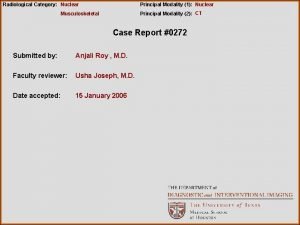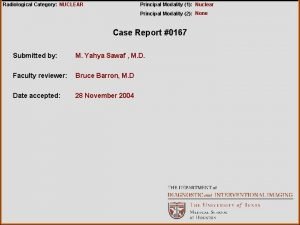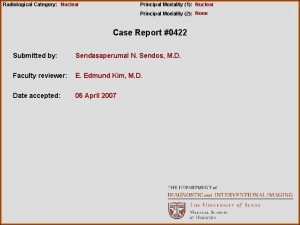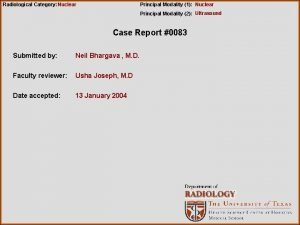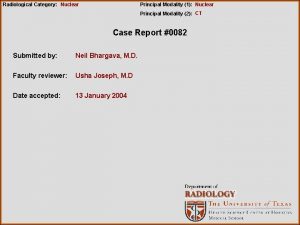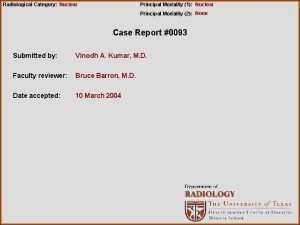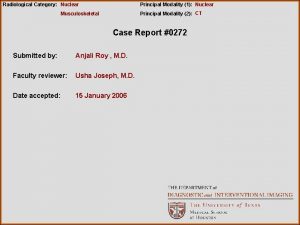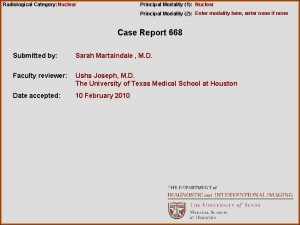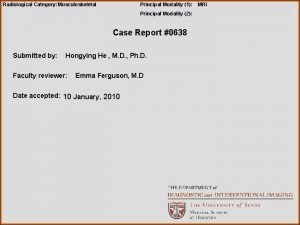Radiological Category Nuclear Medicine Principal Modality 1 Nuclear














- Slides: 14

Radiological Category: Nuclear Medicine Principal Modality (1): Nuclear scintigraphy Principal Modality (2): None Case Report # 0856 Submitted by: Sireesha Yedururi, M. D. Faculty reviewer: Michele Lesslie, D. O. Date accepted: September 2011

Case History 60 year old with abdominal pain. Remaining history is withheld.

Radiological Presentations Anterior sequential technitium-99 m HIDA Scan

Radiological Presentations Further delayed anterior sequential technitium-99 m HIDA Scan

Test Your Diagnosis Which one of the following is your choice for the appropriate diagnosis? After your selection, go to next page. • Acute cholecystitis • Acute complete/high grade common bile duct obstruction • Partial distal common bile duct obstruction • Biliary atresia • Hepatocellular dysfunction (e. g. acute hepatitis) • Chronic cholecystitis

Findings and Differentials Findings: The sequential anterior HIDA images demonstrate persistent absence of biliary tree activity, absent bowel activity and constantly increasing activity in the liver (hot liver sign) Differentials: • Acute complete/high grade common bile duct obstruction. • Acute cholecystitis • Spasm of the sphincter of Oddi • Partial common bile duct obstruction • Chronic cholecystitis

Discussion The hot liver scan sign is a typical finding in acute high grade/complete obstruction of the biliary tree. It could be mechanical (stones, malignant neoplasm) or functional (some cases of ascending cholangitis and intrahepatic cholestasis). The patients imaging findings are fairly typical for acute complete biliary obstruction. In partial obstruction of the common bile duct, the gall bladder and common duct are clearly visualized to the level of obstruction. The liver usually accumulates activity slower than normal but there is definite but delayed hepatic clearance resulting in delayed intestinal activity. It could be due to stones, benign or malignant stricture or sphincter of Oddi dysfunction/spasm with elevated sphincter pressure. In acute calculous cholecystitis, there will be no tracer activity in the gall bladder. However, prompt activity is seen in the common duct and bowel. Delayed gall bladder activity is seen in in either acute acalculous cholecystitis or chronic cholecystitis. Normal tracer activity is again seen in the common duct and bowel.

Discussion Our patient has a history of gall stones and common bile ducts on prior recent CT imaging. A HIDA scan 3 days prior to the current scan showed findings typical of partial common bile duct obstruction. The anterior projection images of the prior HIDA 3 days back (slides 9 and 10) shows normal gall bladder activity and common bile duct activity to the level of obstruction distally. No bowel activity is seen on the initial images up to 4 hours. But, a 24 hour delayed image shows definite bowel activity confirming delayed clearance and partial obstruction. The patient underwent an ERCP, common duct stones removal and sphincterotomy one day prior to the HIDA scan. The spot image (slide 11) shows multiple calculi within the gall bladder lumen. A complete bile duct obstruction was considered less likely on the current scan given the history of sphincterotomy. Spasm/cholestatsis was considered a more likely diagnostic possibility and it was decided to get a 24 hour follow up image (slide 12) which showed activity in the bowel and no activity in the gall bladder. Hence a diagnosis of acute cholecystitis superimposed on partial common duct obstruction most likely due to spasm or cholestasis is made.

Radiological Presentations

Radiological Presentations

Radiological Presentations

Radiological Presentations 24 hour delayed HIDA image from the current scan

Diagnosis Hot liver scan sign in a patient with acute cholecystitis and partial common duct obstruction believed to be due to spasm/cholecystitis.

References Mettler FA, Guiberteau MJ. Chapter 8, Gastrointestinal tract. Essentials of Nuclear Medicine Imaging: 2006; 203 - 241
 Erate category 2
Erate category 2 Tennessee division of radiological health
Tennessee division of radiological health Center for devices and radiological health
Center for devices and radiological health National radiological emergency preparedness conference
National radiological emergency preparedness conference Radiological dispersal device
Radiological dispersal device Nuclear medicine information system
Nuclear medicine information system Nuclear medicine lectures
Nuclear medicine lectures Medical case study presentation
Medical case study presentation Venus in medical terms
Venus in medical terms Measles artifact nuclear medicine
Measles artifact nuclear medicine Spatial resolution
Spatial resolution Mt sinai nuclear medicine
Mt sinai nuclear medicine Filtered back projection
Filtered back projection Diaphragm
Diaphragm Fisión nuclear vs fision nuclear
Fisión nuclear vs fision nuclear





